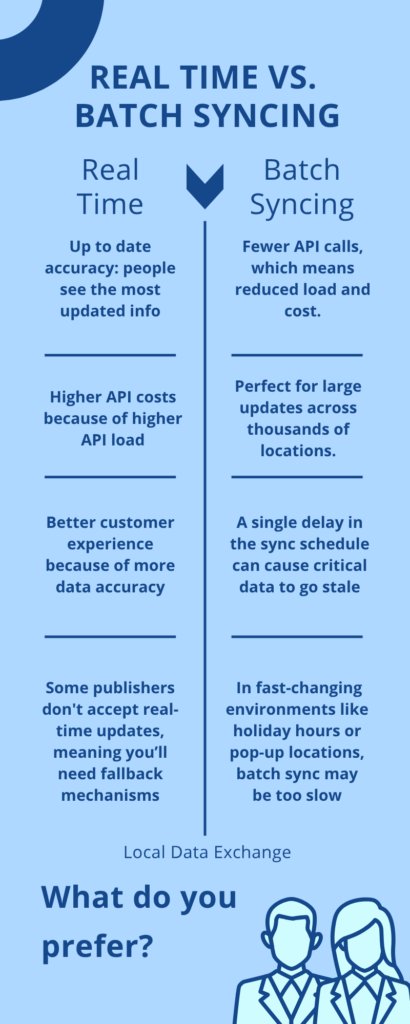When managing local data at scale, especially for multi-location businesses, how you sync that data across platforms can make or break your online presence. Whether you’re syndicating location data, managing business listings, or updating customer reviews, the choice between real-time and batch syncing is critical. Each method has its place, and the right choice depends on your technical needs, business objectives, and how often your data changes.
In this guide, we’ll break down what real-time and batch syncing mean, compare their pros and cons, and help you determine which is the best approach for your local data API strategy.
What is Real-Time Syncing?
Real-time syncing means your data is pushed or updated immediately when a change is made. For example, if a business changes its opening hours in your central database, that update is instantly reflected across connected platforms like Google, Yelp, or Bing.
Key features of real-time syncing:
- Data changes are sent as soon as they occur.
- Uses event-driven architecture, often through webhooks or streaming APIs.
- Ideal for high-priority updates like business hours or service availability.
What is Batch Syncing?
Batch syncing, on the other hand, means data is collected and updated in chunks at scheduled intervals (e.g., hourly, nightly, weekly). This is common for bulk data operations or when working with platforms that don’t support real-time updates.
Key features of batch syncing:
- Updates are grouped and sent at once.
- Scheduled (cron-based or via batch jobs).
- More efficient for large data sets that don’t change often.
Pros and Cons of Real-Time Syncing
Pros:
- Up-to-Date Accuracy: Consumers always see the most current information—no outdated hours or incorrect locations.
- Improved Local SEO: Faster updates can help maintain listing consistency, a critical ranking factor.
- Better Customer Experience: Real-time accuracy means fewer frustrated users showing up at closed stores or calling outdated phone numbers.
- Automated Workflows: Real-time events can trigger other workflows, like notifying teams or updating CRMs instantly.
Cons:
- Higher API Load: Every change triggers a request, which can lead to performance issues or higher API usage costs.
- Complex Infrastructure: Real-time syncing often requires event brokers, webhooks, and robust error handling to avoid data mismatch.
- Platform Limitations: Some publishers don’t accept real-time updates, meaning you’ll need fallback mechanisms.
Pros and Cons of Batch Syncing
Pros:
- Efficiency at Scale: Perfect for large updates across thousands of locations. You can send one batch request instead of thousands of individual updates.
- Lower Operational Overhead: Fewer API calls, which means reduced load and cost—great for resource-conscious teams.
- Simplicity: Easier to implement and monitor. One failed batch can be retried without disrupting the whole system.
Cons:
- Outdated Data Risk: A single delay in the sync schedule can cause critical data to go stale.
- Longer Time-to-Update: Customers and platforms may not see updates until hours—or even days—later.
- Missed Opportunities: In fast-changing environments like holiday hours or pop-up locations, batch sync may be too slow.

Which One is Better for Local Data?
There’s no one-size-fits-all answer. The right approach depends on:
- How often your data changes
- The number of locations you manage
- Which publishers you’re syncing to
- Your available technical resources and API limits
Many advanced local data APIs today offer hybrid approaches, where high-priority updates (like changes to hours) are pushed in real-time, while lower-priority bulk data (like descriptions or attributes) are synced in batches.
Local Data Exchange’s Hybrid Syncing Approach
At Local Data Exchange, our Listings API supports both real-time and batch syncing. We understand that not every update needs to happen instantly, but some definitely do. Our packages are designed to give you control and flexibility. You choose what gets synced, when, and how, based on your business rules and platform requirements.
By combining real-time triggers for critical changes and scheduled syncs for large-scale data management, we help multi-location brands stay visible, consistent, and competitive.
Choosing between real-time and batch syncing isn’t just a technical decision, it’s a strategic one. When managed correctly, syncing impacts everything from your SEO performance to customer satisfaction and operational efficiency.
For SaaS providers, agencies, and multi-location brands looking to scale, having the right syncing strategy in place is essential to stay ahead in the digital ecosystem.


